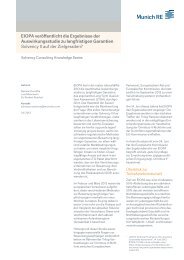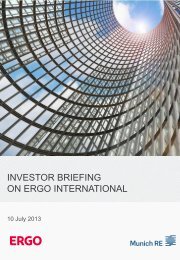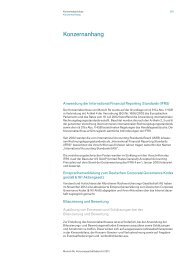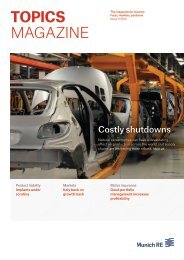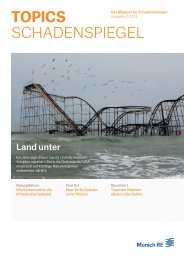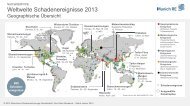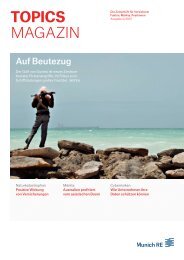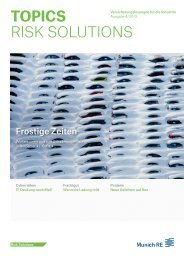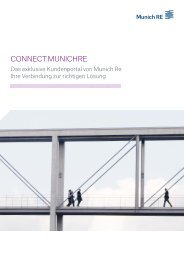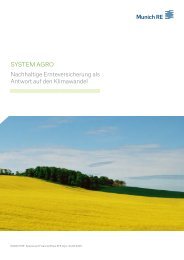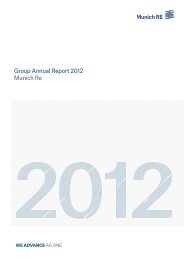Munich Re Group Annual Report 2006 (PDF, 1.8
Munich Re Group Annual Report 2006 (PDF, 1.8
Munich Re Group Annual Report 2006 (PDF, 1.8
You also want an ePaper? Increase the reach of your titles
YUMPU automatically turns print PDFs into web optimized ePapers that Google loves.
<strong>Munich</strong> <strong>Re</strong> <strong>Group</strong> <strong>Annual</strong> <strong>Re</strong>port <strong>2006</strong> General information_Glossary<br />
R – S<br />
Rating<br />
Standardised assessment of the credit standing of debt instruments<br />
and companies by specialised independent rating agencies.<br />
<strong>Re</strong>coverable amount<br />
Under IFRSs, the recoverable amount of an asset is the higher of net<br />
sales price (i.e. sales price less sales costs) and the value in use (i.e.<br />
present value of the future cash flows). The recoverable amount<br />
plays a part especially in connection with impairments in the value of<br />
real estate, where an impairment loss has to be recognised if the<br />
recoverable amount is lower than the carrying amount.<br />
<strong>Re</strong>gistered shares<br />
Shares registered in the owner’s name. They are entered in the company’s<br />
share register with the shareholder’s personal data and the<br />
number of shares held.<br />
<strong>Re</strong>insurer<br />
Insurance company that assumes the insurance risks of other insurance<br />
companies without itself having any direct contractual relationship<br />
with the policyholder.<br />
<strong>Re</strong>insurance capacity<br />
Amount of cover that a reinsurance company or the market as a<br />
whole can make available.<br />
<strong>Re</strong>newals<br />
Although obligatory reinsurance agreements contain agreed periods<br />
of notice, they are generally concluded for an unlimited duration.<br />
These treaties between insurers and reinsurers may therefore run<br />
for long periods. In such cases, the treaty conditions are usually<br />
adjusted in renewal negotiations each year, and the treaties<br />
renewed.<br />
<strong>Re</strong>tention<br />
That part of the risk assumed which the insurer/reinsurer does not<br />
reinsure/retrocede, i.e. retains net for own account.<br />
<strong>Re</strong>trocessionaire<br />
<strong>Re</strong>insurer that reinsures reinsurance business assumed by other<br />
insurance companies. <strong>Re</strong>trocession enables the reinsurer to lay off<br />
part of its risk to other insurance companies.<br />
<strong>Re</strong>turn on equity (ROE)<br />
Indicator for measuring a company’s financial performance. It is calculated<br />
as a percentage ratio of the result for the period to the average<br />
equity employed.<br />
Risk<br />
The possibility of negative factors influencing the future economic<br />
situation of company. In insurance, it is also understood to mean the<br />
possibility of a loss being caused by an insured peril. In addition,<br />
insured objects or persons are frequently referred to as risks.<br />
Risk capital<br />
The amount of capital hypothetically assigned for the conducting of<br />
insurance or reinsurance business to ensure that the probability of<br />
default in respect of the portion of the business exposed to risk is<br />
kept to a minimum. The capital required for this purpose is calculated<br />
using mathematical risk and financing models.<br />
Risk controlling<br />
Ongoing monitoring and control of risks and measures, including<br />
methodological development and risk analysis/reporting, by a neutral,<br />
independent unit that also proposes and initiates additional<br />
measures.<br />
Risk management<br />
Systematic and continual identification, analysis, evaluation and<br />
control of potential risks that may jeopardise the assets, liabilities,<br />
financial position and results of a company in the medium to long<br />
term. The aim is to safeguard the existence of the company and its<br />
objectives against disruptive influences by means of suitable measures,<br />
and to increase corporate value.<br />
Risk trading<br />
Trading of risks on the capital markets.<br />
Run-off triangle<br />
Also known as “loss triangle”, this is a tabular representation of<br />
claims-related data (such as payment, claims reserve, ultimate<br />
loss) in two, time-related dimensions. One of these is the calendar<br />
year, while the other is usually the accident year (year of the loss<br />
occurrence).<br />
Run-off triangles – as the basis for measuring claims reserves – make<br />
clear how the claims reserve changes over the course of time due to<br />
payments made and new estimates of the expected ultimate loss at<br />
the respective balance sheet date.<br />
Scenario analysis<br />
Type of analysis used to investigate how certain key figures (market<br />
values or carrying amounts) change in the event that predefined<br />
market developments occur. Scenario analyses usually take the form<br />
of average if-then analyses.<br />
225



